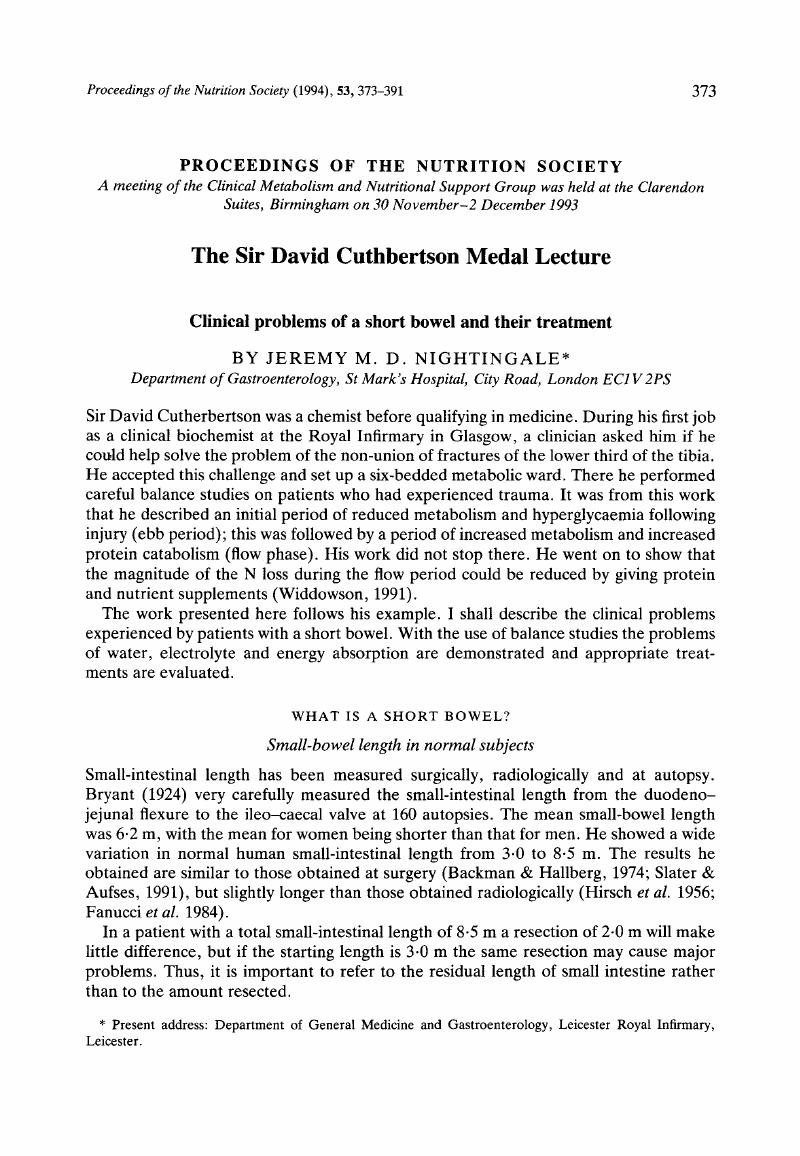Crossref Citations
This article has been cited by the following publications. This list is generated based on data provided by Crossref.
Messing, Bernard
Crenn, Pascal
Beau, Philippe
Boutron-Ruault, Marie Christine
Rambaud, Jean-Claude
and
Matuchansky, Claude
1999.
Long-term survival and parenteral nutrition dependence in adult patients with the short bowel syndrome.
Gastroenterology,
Vol. 117,
Issue. 5,
p.
1043.
VAN GOSSUM, A.
VAHEDI, K.
ABDEL-MALIK
STAUN, M.
PERTKIEWICZ, M.
SHAFFER, J.
HEBUTERNE, X.
BEAU, P.
GUEDON, C.
SCHMIT, A.
TJELLESEN, L.
MESSING, B.
and
FORBES, A.
2001.
Clinical, social and rehabilitation status of long-term home parenteral nutrition patients: results of a European multicentre survey.
Clinical Nutrition,
Vol. 20,
Issue. 3,
p.
205.
Agwunobi, A. O.
Carlson, G. L.
Anderson, I. D.
Irving, M. H.
and
Scott, N. A.
2001.
Mechanisms of intestinal failure in Crohn's disease.
Diseases of the Colon & Rectum,
Vol. 44,
Issue. 12,
p.
1834.
Nightingale, Jeremy M D
2001.
Management of patients with a short bowel.
World Journal of Gastroenterology,
Vol. 7,
Issue. 6,
p.
741.
Simic, Dusica
and
Djurisic, Nebojsa
2003.
Nutritive support in short Bowel syndrome (sbs).
Srpski arhiv za celokupno lekarstvo,
Vol. 131,
Issue. 1-2,
p.
77.
Nagy, ??va S.
Paris, Monique C. J.
Taylor, Russell G.
Fuller, Peter J.
Sourial, Magdy
Justice, Fran
and
Bines, Julie E.
2004.
Colostrum Protein Concentrate Enhances Intestinal Adaptation After Massive Small Bowel Resection in Juvenile Pigs.
Journal of Pediatric Gastroenterology and Nutrition,
Vol. 39,
Issue. 5,
p.
487.
Messing, B.
Joly, Francisca
Badran, A.M.
and
penven rousseau, Sophie
2004.
Traitement diététique et nutritionnel des résections intestinales.
Cahiers de Nutrition et de Diététique,
Vol. 39,
Issue. 5,
p.
319.
Nagy, Èva S.
Paris, Monique C. J.
Taylor, Russell G.
Fuller, Peter J.
Sourial, Magdy
Justice, Fran
and
Bines, Julie E.
2004.
Colostrum Protein Concentrate Enhances Intestinal Adaptation After Massive Small Bowel Resection in Juvenile Pigs.
Journal of Pediatric Gastroenterology and Nutrition,
Vol. 39,
Issue. 5,
p.
487.
Seguy, David
2005.
Conséquences nutritionnelles de la chirurgie digestive.
Nutrition Clinique et Métabolisme,
Vol. 19,
Issue. 1,
p.
9.
Messing, Bernard
and
Joly, Francisca
2006.
Guidelines for Management of Home Parenteral Support in Adult Chronic Intestinal Failure Patients.
Gastroenterology,
Vol. 130,
Issue. 2,
p.
S43.
Bonifacio, R.
Alfonsi, L.
Santarpia, L.
Orban, A.
Celona, A.
Negro, G.
Pasanisi, F.
and
Contaldo, F.
2007.
Clinical outcome of long-term home parenteral nutrition in non-oncological patients: a report from two specialised centres.
Internal and Emergency Medicine,
Vol. 2,
Issue. 3,
p.
188.
Joly, Francisca
Coffin, Benoît
and
Messing, Bernard
2007.
Rôle de la flore dans les pathologies digestives (maladie de Crohn, rectocolite ulcérohémorrhagique, cancer colorectal exclus).
Nutrition Clinique et Métabolisme,
Vol. 21,
Issue. 2,
p.
89.
Joly, F.
Corcos, O.
Ghandour, F.
Pingenot, I.
and
Messing, B.
2007.
Traité de nutrition artificielle de l’adulte.
p.
959.
Pereira‐Fantini, Prue M
Nagy, Eva S
Thomas, Sarah L
Taylor, Russell G
Sourial, Magdy
Paris, Monique CJ
Holst, Jens J
Fuller, Peter J
and
Bines, Julie E
2008.
GLP‐2 Administration Results in Increased Proliferation but Paradoxically an Adverse Outcome in a Juvenile Piglet Model of Short Bowel Syndrome.
Journal of Pediatric Gastroenterology and Nutrition,
Vol. 46,
Issue. 1,
p.
20.
Szczygiel, Bruno
Jonkers-Schuitema, Cora F.
and
Naber, Ton
2010.
Basics in Clinical Nutrition: Nutritional support in extensive gut resections (short bowel).
e-SPEN, the European e-Journal of Clinical Nutrition and Metabolism,
Vol. 5,
Issue. 1,
p.
e63.
Baker, M. L.
Williams, R. N.
and
Nightingale, J. M. D.
2011.
Causes and management of a high-output stoma.
Colorectal Disease,
Vol. 13,
Issue. 2,
p.
191.
Amiot, Aurelien
Messing, Bernard
Corcos, Olivier
Panis, Yves
and
Joly, Francisca
2013.
Determinants of home parenteral nutrition dependence and survival of 268 patients with non-malignant short bowel syndrome.
Clinical Nutrition,
Vol. 32,
Issue. 3,
p.
368.
Nuzzo, A.
Joly, F.
and
Corcos, O.
2014.
Syndrome de grêle court et défaillance intestinale aiguë en réanimation.
Réanimation,
Vol. 23,
Issue. 6,
p.
676.
Klek, Stanislaw
Szczepanek, Kinga
Hermanowicz, Adam
and
Galas, Aleksander
2015.
Taurolidine Lock in Home Parenteral Nutrition in Adults.
Journal of Parenteral and Enteral Nutrition,
Vol. 39,
Issue. 3,
p.
331.
Joly, Francisca
Boehm, Vanessa
Bataille, Julie
Billiauws, Lore
and
Corcos, Olivier
2016.
Parcours de soins du patient adulte souffrant de syndrome de grêle court avec insuffisance intestinale.
Nutrition Clinique et Métabolisme,
Vol. 30,
Issue. 4,
p.
385.



